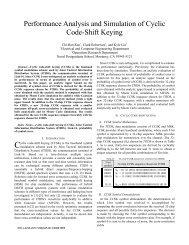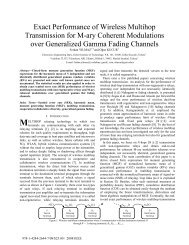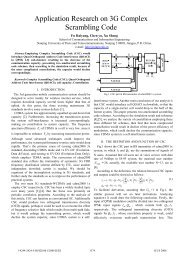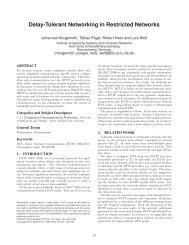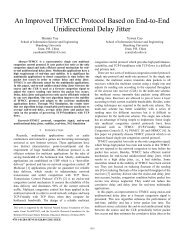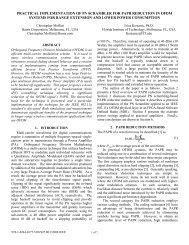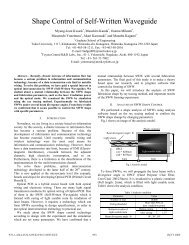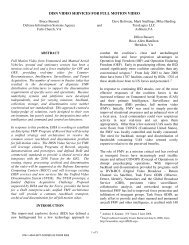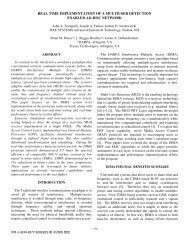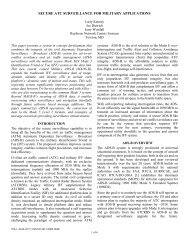2. Research On Streaming Media Online Charging System
2. Research On Streaming Media Online Charging System
2. Research On Streaming Media Online Charging System
You also want an ePaper? Increase the reach of your titles
YUMPU automatically turns print PDFs into web optimized ePapers that Google loves.
<strong>Research</strong> <strong>On</strong> <strong>Streaming</strong> <strong>Media</strong> <strong>On</strong>line <strong>Charging</strong><br />
<strong>System</strong><br />
ZhenGuo Kuang, Zhihui Ji<br />
National Network New <strong>Media</strong> Engineering <strong>Research</strong><br />
Center, Institute of Acoustics, Chinese Academy of<br />
Sciences<br />
Graduate University of Chinese Academy of Sciences<br />
Beijing 100049, PRChina<br />
{kuangzg,jizh}@dsp.ac.cn<br />
Abstract—Prepaid services require the billing system to offer<br />
real-time billing and service control in streaming media<br />
applications. However, current billing approaches suffer from<br />
high risk of bad debts to operators or lack of the function of<br />
service termination during service consumption. <strong>On</strong> the basis of<br />
streaming media services’ features, a <strong>Streaming</strong> <strong>Media</strong> <strong>On</strong>line<br />
<strong>Charging</strong> <strong>System</strong> (SMOCS) is developed in this paper. The online<br />
charging process for typical streaming media service-VoD service<br />
is proposed, and a performance optimization scheme by adopting<br />
main memory database technology is provided to improve the<br />
efficiency of online charging. When comparing with shared<br />
memory schema, SMOCS obtains an obvious average processing<br />
time reduction (by almost 95%), and it could effectively satisfy<br />
real-time billing requirements of streaming media services.<br />
Keywords-<strong>On</strong>line <strong>Charging</strong> <strong>System</strong>; streaming media; real-time<br />
billing; main memory database; Diameter CC<br />
I. INTRODUCTION<br />
With the rapid development of network technology and<br />
more and more needs of customers, the streaming media<br />
services such as Mobile TV, Video-on-Demand (VoD) and<br />
Internet TV spread rapidly. Service diversities and its complex<br />
billing requirements are in need of more powerful billing<br />
system [1].<br />
The postpaid billing approach is rarely adopted by<br />
operators for the following reasons: Firstly, it is difficult to<br />
control bad debts caused by poor credit customers, which<br />
causes huge losses to operators every year [2]; secondly,<br />
customers can’t check their real-time balance and bill records<br />
[1]. The quasi real-time billing approach is also called hot<br />
billing, by which the billing system deducts service fees<br />
immediately after the customer’s service consumption. Though<br />
we can improve the performance of billing systems to shorten<br />
the rebate cycle, the quasi real-time billing approach is<br />
essentially an off-line billing approach and the fixed time<br />
interval will cause operators to suffer higher risk. In addition, it<br />
This work was undertaken at National Network New <strong>Media</strong> Engineering<br />
<strong>Research</strong> Center, Institute of Acoustics, Chinese Academy of Sciences and the<br />
Graduate University of Chinese Academy of Sciences, and was supported by<br />
Hi-Tech <strong>Research</strong> and Development Program of PRChina under contract<br />
number 2008AA01A317 and National Key Technology R&D Program of<br />
PRChina under contract number 2008BAH28B04.<br />
Hong Ni, Lei Liu<br />
National Network New <strong>Media</strong> Engineering <strong>Research</strong><br />
Center, Institute of Acoustics, Chinese Academy of<br />
Sciences<br />
Beijing 100190, PRChina<br />
{nih,liul}@dsp.ac.cn<br />
lacks the function of service termination during the process of<br />
customer consumption [2]. With the increase of service types<br />
and Internet transactions, customers need to pay for valueadded<br />
services provided by the third-party Content Provider or<br />
Service Provider. So a large amount of expenses may arise<br />
within a short time, and this increases arrearage risk further [3].<br />
<strong>On</strong>line charging approach is realized by a mechanism that<br />
whether customers can use the service or not depends on their<br />
account balance. For example, the online charging of voice<br />
service is implemented by means of intelligent network<br />
through CAMEL protocol [8].<br />
Obviously, postpaid billing approach or quasi real-time<br />
billing approach can’t satisfy operators’ demands for the<br />
control of bad debts; neither can they satisfy the customers’<br />
demands for checking their real-time balance and bill records.<br />
In this paper we analyze the shortcomings of existing billing<br />
approaches at first; Then we propose a <strong>Streaming</strong> <strong>Media</strong><br />
<strong>On</strong>line <strong>Charging</strong> <strong>System</strong> (SMOCS) based on features of<br />
streaming media services and their supporting networks [4][5]<br />
and improve its real-time performance by adopting main<br />
memory database technology. SMOCS ensures that streaming<br />
media services are available only when customers have enough<br />
balance. It also offers the function of inquiring real-time<br />
balance and bill records, and provides the function of real-time<br />
service termination during service consuming, which can<br />
effectively satisfy the needs both of operators and customers.<br />
The paper is organized as follows. The design of <strong>Streaming</strong><br />
<strong>Media</strong> <strong>On</strong>line <strong>Charging</strong> <strong>System</strong> is proposed in section <strong>2.</strong> A<br />
performance optimization scheme to improve overall<br />
performance of the system is presented in section 3.<br />
Experimental results are reported in section 4. Finally<br />
conclusions are given in section 5.<br />
II. THE DESIGN OF ARCHITECTURE OF SMOCS<br />
In this section, we give a brief introduction to streaming<br />
media and propose the framework of SMOCS. After in-depth<br />
research on Authentication � Authorization and Accounting<br />
(AAA) protocol, we adopt the Diameter Credit Control<br />
protocol (DiameterCC) [7] in SMOCS to support prepaid<br />
services. Finally, according to the framework of SMOCS, the<br />
online charging process of VoD service is designed.<br />
1-4244-2424-5/08/$20.00 ©2008 IEEE 309<br />
ICCS 2008
A. A brief introduction to streaming media<br />
<strong>Streaming</strong> media refers to the continuous audio/video<br />
stream being transmitted and broadcasted on data network<br />
according to time sequence. With the progress of 3G networks<br />
and the improvement of network condition, the streaming<br />
media services develop rapidly and attract more and more<br />
attention. There has been a streaming media subject- "highperformance<br />
information broadband network 3TNet" subject<br />
that belongs to China’s "863 project". Beginning with typical<br />
broadband streaming media services such as Internet TV, VoD,<br />
High Definition TV, Time-Shifted TV and so on, the subject<br />
established a high-performance, WAN (MAN) broadband<br />
demonstration network 3TNet which is applicable to real-time<br />
transmission of Internet TV and other media streams, and it<br />
was deployed in the Yangtze-River-Delta region. It is so far the<br />
largest integrated application platform for IPv6 interactive<br />
multimedia broadband network.<br />
B. Architecture of <strong>Streaming</strong> <strong>Media</strong> <strong>On</strong>line <strong>Charging</strong> <strong>System</strong><br />
The function of <strong>On</strong>line <strong>Charging</strong> <strong>System</strong> (OCS) is to<br />
response to charging requests in real time, finish rating<br />
according to billing policies, give feedbacks after deducting<br />
corresponding service fees and generate billing details.<br />
Furthermore, OCS ought to monitor customers’ account<br />
balance and control service consumption in real time. In the<br />
specification of R5 & R6, 3GPP proposed OCS and defined the<br />
reference framework of OCS for IMS network [6]. The OCS<br />
proposed by 3GPP is aimed at charging requirements of<br />
telecom services and it is complex to support CAMEL<br />
protocol. However, streaming media services have their own<br />
features as multimedia, personalized interaction,<br />
humanization, and their supporting networks are almost IPbased<br />
broadband networks. In order to make the SMOCS<br />
support streaming media services more effective and the<br />
system be more scalable and more compatible, we design a<br />
Common Interface Function (CIF) module to unify the<br />
interaction with external devices, add the Session Management<br />
module to monitor charging request session information and<br />
adopt DiameterCC protocol to interact with streaming media<br />
service control servers. <strong>On</strong> the principle of the separation<br />
between billing control and billing applications, according to<br />
function requirements of OCS in streaming media applications,<br />
taking advantage of 3GPP’s related research achievements<br />
[14], we designed architecture of <strong>Streaming</strong> <strong>Media</strong> <strong>On</strong>line<br />
<strong>Charging</strong> <strong>System</strong> and it consists of Common Interface module,<br />
<strong>Charging</strong> module, Account Balance Management module,<br />
<strong>Charging</strong> gateway module, Rating module and Session<br />
Management module. The detailed architecture of SMOCS is<br />
shown in Figure 1.<br />
310<br />
Figure 1. Framework of the <strong>Streaming</strong> <strong>Media</strong> <strong>On</strong>line <strong>Charging</strong> <strong>System</strong><br />
Access Convergence Router (ACR) and <strong>Media</strong> Server (MS)<br />
are service control network elements in streaming media<br />
application systems. They interact with SMOCS by<br />
DiameterCC Protocol and realize the online charging function<br />
in coordination. ACR in the backbone of network controls the<br />
multicast of Internet TV, High Definition TV, Broadband<br />
access, etc. MS around the edge of Metropolitan Area Network<br />
(MAN) provides streaming service of VoD, Time-Shifted TV,<br />
Time-shift VoD and other stream services for terminals.<br />
SMOCS specifies a CIF module to unify the interaction with<br />
external network devices and enhance the system’s<br />
compatibility. CIF module interacts with external network<br />
devices through DiameterCC Protocol and IPDR [10] file for<br />
real-time billing information and billing details respectively;<br />
<strong>Charging</strong> function module is one of control modules and it<br />
supports charging function based on session, beater and events;<br />
Rating function module is the charge calculation module and it<br />
supports charging calculation for a variety of services through<br />
configuration of billing rules; Main function of Account<br />
Balance Management Function (ABMF) is monitoring<br />
customers’ account balance, including reserving/releasing<br />
account balance, deducting service fees, inquiring real-time<br />
balance, etc. When a customer’ balance is below a dynamically<br />
calculated threshold based on the customer’s level and history<br />
bill records, the module reminds the customer to recharge<br />
through short messages or E-mails; Main function of Session<br />
Management Function (SMF) is to establish/close sessions,<br />
monitor status of sessions and maintain session information;<br />
According to pre-determined strategy in SMOCS, charging<br />
Gateway produces IPDR files for further dealings in<br />
accounting system [8].<br />
C. <strong>Research</strong> on the AAA protocol<br />
The Remote Authentication Dial In User Service<br />
(RADIUS) protocol is one of the most popular AAA protocols<br />
and it is widely used for its simpleness, easy management and<br />
nice expansibility. However, RADIUS protocol can’t be<br />
adapted to current networks for its own defects, such as<br />
transmission by the unreliable UDP protocol, simple package<br />
drop mechanism, without rules about retransmission and the<br />
concentrated billing service mechanism. So the Diameter<br />
protocol [10] is proposed. The Diameter protocol provides a<br />
safe, reliable and scalable framework for various authentication<br />
authorization and accounting services, and it can be applied to<br />
practical applications conveniently. Compared to RADIUS<br />
protocol, Diameter protocol has a nice mechanism to handle<br />
transmission failure, the ability to rapidly detect the receiving<br />
peer, and a better package drop mechanism. In addition, it<br />
supports end-to-end security and makes authenticates and<br />
authorizes for each session to ensure security. Based on<br />
Diameter, DiameterCC protocol defines a billing mechanism<br />
for prepaid services, adopts credit control mechanism to realize<br />
session based charging, bearer based charging and event based<br />
charging. And it satisfies billing requirements for prepaid<br />
services. Therefore, SMOCS designed in this paper interacts<br />
with external network devices by this protocol to realize online<br />
charging function.
D. <strong>On</strong>line charging process of VoD service<br />
According to framework of SMOCS shown in Figure1, we<br />
take VoD service as an example to discuss online charging<br />
process of streaming media services. The detailed online<br />
charging process of VoD service is shown in Figure <strong>2.</strong> The<br />
process includes six sub-processes: Sub-process 6 assesses the<br />
customer’s account balance and the accumulated usage of the<br />
service. Sub-process 7 calculates charges of the charging<br />
request; Sub-process 8 deducts service fees from the<br />
customer’s account; Sub-process 11 produces IPDR files<br />
according to billing detail information; Sub-process 13 refunds<br />
after customer‘s service failures; Sub-process 14 reminds the<br />
customer to recharge when the account balance is below a<br />
dynamically-calculated threshold.<br />
III. PERFORMANCE OPTIMIZATION OF SMOCS<br />
There are a lot of data accessing operations during the<br />
process of online charging, so the efficiency of data accessing<br />
operations plays an important part in real-time performance of<br />
SMOCS. In addition, the SMOCS has been an important part<br />
Figure <strong>2.</strong> The detailed online charging process of VoD service<br />
311<br />
Obviously, MSOCS has the following advantages: Firstly,<br />
SMOCS adopts advanced DiameterCC protocol to support<br />
streaming media prepaid services, which avoids the complexity<br />
of supporting CAMEL protocol and security problems caused<br />
by AAA protocol; Secondly, the CIF module unifies the<br />
interaction with external network devices, which enhances<br />
compatibility of the system; Furthermore, the SMF module<br />
manages the online charging session information and it is<br />
convenient to support multi-services and flexible billing<br />
policies in SMOCS. Finally, ABMF reminds the customer to<br />
recharge, when the customer’s balance is below a dynamically<br />
calculated threshold based on customer’s level and history bill<br />
records, and this function greatly reduces service terminations<br />
due to insufficient balance, while reducing the pressure on<br />
SMOCS caused by real-time service control.<br />
of streaming media service platform and has direct impact on<br />
the use of normal services, and thus it is requested to offer<br />
higher performance in security, real-time, reliability, etc. To<br />
improve the efficiency of data accessing operation and overall<br />
performance of SMOCS, we provide a system performance<br />
optimization schema in this section.
A. Summary of data accessing methods<br />
The widely used data accessing methods including Open<br />
Database connectivity (ODBC) method, sharing memory<br />
method [11] and the main memory database method [12], etc.<br />
The introductions to them are as follows.<br />
By ODBC method, data updating and inquiry are realized<br />
by Database Management <strong>System</strong> (DBMS) and the data<br />
needed in applications is accessed from the database through<br />
ODBC. Data management and transaction assurance are<br />
implemented by DBMS, which greatly reduces the difficulty<br />
of application development. Data accessing relies on DBMS<br />
by this method, so the delay of SMOCS’s response to charging<br />
requests will increase and concurrency performance of<br />
SMOCS will be limited by the overall performance of used<br />
database.<br />
By sharing memory method, the data storied in shared<br />
space of main memory is provided for all processes and we<br />
don’t have to save more copies. The relatively stable or readonly<br />
data can be rapidly accessed through shared memory. The<br />
application program does the data updating procedure and<br />
ensures the consistency of the data between shared memory<br />
and database, and thus it increases the difficulty to the<br />
development of application program. By this method we can<br />
access stable data easily, but can’t handle the frequent data<br />
updating procedure effectively in SMOCS.<br />
By main memory database method, almost all data are<br />
stored in main memory to be operated directly. Architecture of<br />
main memory database has been re-designed on the basis of all<br />
data in main memory, and corresponding improvement has<br />
been made in data cache mechanism, fast algorithms, parallel<br />
operations, etc. So the data processing speed of main memory<br />
database is 10 to 100 times that of traditional database. Main<br />
memory database such as TimesTen [13] and eXtremeDB has<br />
been widely used in applications.<br />
B. Performance optimization of <strong>Streaming</strong> <strong>Media</strong> <strong>On</strong>line<br />
<strong>Charging</strong> <strong>System</strong> based on Main Memory Database<br />
Through the analysis of data accessing methods above, we<br />
can greatly improve the efficiency of data accessing. It is<br />
realized by adopting main memory database to manage<br />
customers’ basic information, account balance, accumulated<br />
usage and fees, session information, and billing detail<br />
information in SMOCS. This can greatly improve the speed of<br />
online charging, concurrency and real-time performance of<br />
SMOCS. So a main memory database function (MMDB<br />
Function) module is added to SMOCS’s framework to manage<br />
data information, which not only can reduce the difficulty of<br />
developing SMOCS, but also improve overall performance of<br />
the system. Integrated with main memory database, new<br />
framework of SMOCS is shown in Figure 3.<br />
Making use of main memory database, the new SMOCS<br />
has the following additional advantages:<br />
• Data accessing speed of SMOCS can be improved<br />
greatly due to the storage of account balance, the<br />
accumulated usage and fee, and session information in<br />
main memory;<br />
312<br />
• The main memory database not only improves the<br />
speed of data accessing, but also ensures the data<br />
integrity and reliability by its own copy mechanism<br />
and security strategy;<br />
• For large-scale concurrent charging requests and<br />
shared data accessing, adopting lock mechanism in<br />
main memory database, SMOCS ensures that multithreads/processes<br />
can access critical data safely, and<br />
thus reduces the difficulty of system development.<br />
Figure 3. Framework of SMOCS based on main memory database<br />
IV. EXPERIMENTAL RESULTS<br />
To verify reasonableness of SMOCS’s framework and<br />
performance optimization results of the system, the functions<br />
and performance of the system are tested, with the emphasis<br />
on the average online charging response time. Description of<br />
the test is as follows.<br />
• Oracle9i and Oracle Times Ten In-Memory Database<br />
7.0.5 as database were used respectively. The database<br />
and SMOCS were deployed on two different servers in<br />
the LAN.<br />
• The online charging process of VoD service was<br />
tested. There were 10,000 videos charged by times,<br />
each video was charged differently and every<br />
customer’s ceiling charges are less than��10 within<br />
an account cycle.<br />
• A condition of 100,000 customers sending 100,000<br />
charging requests in all was simulated, and the<br />
customers’ basic information and account balance<br />
were stored in database. The session information and<br />
billing details produced during the online charging<br />
process were saved into database.<br />
• The online charging process was simplified as<br />
initializing a session, accessing customer’s account<br />
balance and accumulated usage, rating, deducting<br />
service fees and generating billing details, the<br />
processing time of online charging was recorded in the<br />
test and the average processing time was computed.<br />
The test includes the following two groups:<br />
• Shared memory scheme. The SMOCS loaded the<br />
customers’ basic information and account balance,<br />
price information of videos and other data at startup,
and then initialized customers’ accumulated usage and<br />
fees. Session information, balance updating and billing<br />
detail information were saved into database during the<br />
process of online charging.<br />
• Main memory database scheme. The main memory<br />
database processed the loading and storing data such<br />
as customers’ account balance, accumulated usage and<br />
fees, session information, billing detail information<br />
and so on. The SMOCS modules accessed data<br />
through standard interface.<br />
Four groups of experimental results are shown in Figure 4<br />
and we can draw the conclusions: optimized by main memory<br />
database, the average processing time of online charging of<br />
SMOCS is reduced by almost 95%, comparing with shared<br />
memory schema. In use of main memory database technology,<br />
SMOCS can effectively access data during online charging<br />
process, which enhances the concurrency and real-time<br />
performance of SMOCS. Therefore, a great improvement of<br />
the system’s overall performance is achieved.<br />
Figure 4. Average processing time of <strong>On</strong>line <strong>Charging</strong> of SMOCS<br />
V. CONCLUSIONS<br />
In streaming media applications, post-paid billing approach<br />
and quasi-real-time billing approach can’t satisfy streaming<br />
media operators’ demand for the control of bad debts, neither<br />
can they satisfy customers’ demand for checking their realtime<br />
balance and bill records. Prepaid services paid monthly<br />
are not widely accepted for their relatively high monthly rent,<br />
due to unrestricted amount of service usage. The disadvantages<br />
of existing billing approaches and practical requirements of<br />
streaming media services are analyzed firstly. And then<br />
SMOCS is proposed according to features of streaming media<br />
services and their supporting networks. Furthermore the online<br />
charging process of typical streaming media service-VoD<br />
service is introduced. Finally by using main memory database<br />
technology, an optimization scheme is provided to improve<br />
overall performance of the system. According to the<br />
experimental results, SMOCS obtains an obvious reduction on<br />
the average processing time of online charging. SMOCS can<br />
effectively support the development of streaming media<br />
services and be helpful to make a rapid promotion for<br />
streaming media services.<br />
313<br />
ACKNOWLEDGMENT<br />
This work is supported by Hi-Tech <strong>Research</strong> and<br />
Development Program of China under contract number<br />
2008AA01A317 and National Key Technology R&D<br />
Program of China under contract number 2008BAH28B04,<br />
their support is highly appreciated. The authors would like to<br />
thank the anonymous reviewers. Their valuable comments<br />
have significantly improved the quality of this paper. Their<br />
efforts are highly appreciated.<br />
[1]<br />
REFERENCES<br />
Yan Zhuang, Zheng Shi, “The Evolution Approaches on <strong>On</strong>line<br />
<strong>Charging</strong> <strong>System</strong> for Mobile Communication Network,” Network<br />
Telecom, no.6 pp. 3<strong>2.</strong> 2007.<br />
[2] Tianjian Liu, Zhenyong Zhou, Dongzhao Zhu, “ Probe into the Solution<br />
for Arrear Controls of Quasi- Real Time Billing <strong>System</strong>,” Designing<br />
Techniques of Posts and Telecommunications, no.5 pp. 13. 2007.<br />
[3] Lianxiang Li, Xiaoliang Liu, Bin Dong, “Convergent <strong>Charging</strong><br />
Approach for 3G Mobile Network,” Telecommunications Science, no.5<br />
pp. 16-18.2006.<br />
[4] 3GPP TS 3<strong>2.</strong>296, <strong>On</strong>line <strong>Charging</strong> <strong>System</strong> (OCS) : “Application and<br />
Interfaces,”. V7.0.00,2006.<br />
[5] 3GPP, 3rd Generation Partnership Project, “Technical Specification<br />
Group Service and <strong>System</strong> Aspects; Telecommunication management;<br />
<strong>Charging</strong> management; Diameter charging applications,” Technical<br />
Specification 3G TS 3<strong>2.</strong>299 Version 6.3.0 2005.<br />
[6] Shengyao Chen; Peter Weik, “Design and Implementation of an<br />
Extensible <strong>On</strong>line <strong>Charging</strong> Architecture for the Open IMS<br />
Playground,” TridentCom 2007. 3rd International Conference,2007.<br />
[7] H.Hakala, L.Mattila, J.-P.Koskinen, M.Stura, and J.Loughney,<br />
[8]<br />
“Diameter credit-control application,” IETF RFC 4006, Aug 2005.<br />
Ya Ding, “Design and Implementation of <strong>On</strong>line <strong>Charging</strong> <strong>System</strong><br />
Based on Diameter,” A Dissertation for Master Degree of Beijing<br />
University of Posts and Telecommunications, pp. 17-18, Mar 2008.<br />
[9] Introduction to IPDR, http://www.ipdr.org/ipdr<br />
[10] Detail information for Diameter Protocol, IETF RFC 3558, “Diameter<br />
Base protocol,” 2003.<br />
[11] Yu Wang, “<strong>Research</strong> <strong>On</strong> Telecom Business Account-billing <strong>System</strong>’s<br />
Data Management Technology,” A Dissertation for Master Degree of<br />
Harbin Engineering University. pp. 14-18, July 2004.<br />
[12] Hector Garcia-Molina, Kenneth Salem, “Main memory database<br />
systems: an overview,”. Knowledge and Data Engineering,IEEE<br />
Transactions on Volume 4, Issue 6, P:509-516,Dec.199<strong>2.</strong><br />
[13] http://www.oracle.com/database/timesten.html<br />
[14] Sok-Ian Sou, Hui-Nien Hung, Yi-Bing Lin, Nan-Fu Peng and Jeu-Yih<br />
Jeng, “Modeling Credit Reservation Procedure for UMTS <strong>On</strong>line<br />
<strong>Charging</strong> <strong>System</strong>,” IEEE Transactions on Wireless Communications,<br />
Vol. 6, No. 11,2007.



